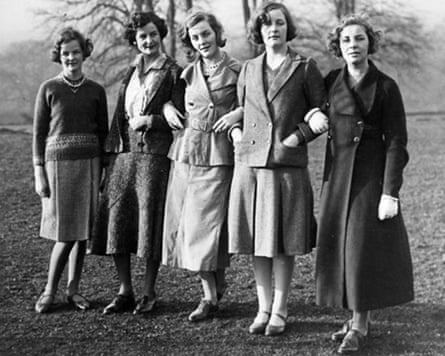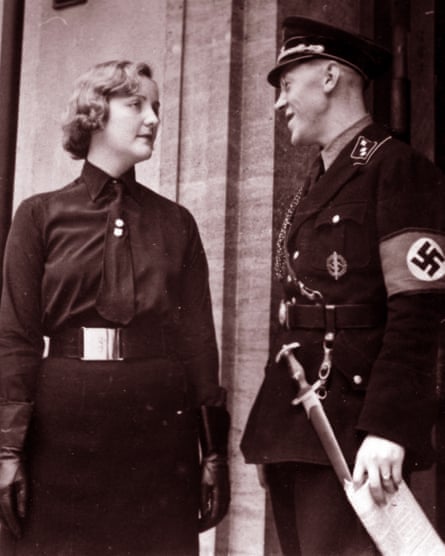The rise and fall of the Mitford sisters is like one of those earthquakes we’re due on a regular rotation: eight years out from Gucci’s much-documented Never Marry a Mitford jumper, four years after the BBC drama The Pursuit of Love, a new TV show appears fortuitously to bring them back into the public consciousness again.
Here they come, out of the mists of time, the seven children of a minor member of the House of Lords: Nancy, of course, the author of Love in a Cold Climate and The Pursuit of Love and probably the most famous in her own right; followed by Pamela, the least famous and fond chiefly of chickens and horrible men; then Tom, the only boy, with a weakness for the Nazis and, as far as history is concerned, no personality.
Then Diana, Mrs Oswald Mosley (Lady Mosley, please, you oik). Then Unity Valkyrie, conceived in the little Canadian town of Swastika, and led presumably by nominative determinism to Hitler’s side; and her best friend and closest sibling, Jessica (Decca), an ardent communist from childhood. Their shared room, famously, had a line down the centre: swastikas and eagles on one side, hammers and sickles the other. The baby of the family, Debo, loved horses and dogs and looking pretty, and became a duchess.

A big, splashy, high-budget period drama, Outrageous is just the latest flowering of Mitford mania. But why do we care? What could possibly be so compelling about six aristocratic women (plus one drippy Nazi-affiliated brother)? As a cast member said in an interview ahead of the show, they are the Kardashians of history, each with their own recognisable brand.
In Charlotte Mosley’s 2007 collection, Letters Between Six Sisters, each sister is given a little symbol: a coronet for example, or a swastika. Even among the family (for of course Mosley is a relation), the sisters cannot escape themselves. Or, perhaps, especially among the family. Who among us is unfamiliar with this feeling? The messy one! The wild card! The golden child! The black sheep! . The beauty? The runaway? The dud? There’s a Mitford for that.
There is, in fact, a Mitford for every possible persuasion: every permutation of political thought, up to and including “eat the rich”, is catered for by this array of blue-blooded, impossibly well-connected women, who are somehow there at every moment of historical significance throughout the 20th century.

We can offer you Churchill’s cousins (both the sisters, through Churchill’s wife Clementine, and Decca’s first husband were Churchill-adjacent); and Hitler’s “angels” (Diana and Unity, described as such by the Fuhrer); forming a band with Maya Angelou (Jessica), or getting tangled up with the curse of the Kennedy clan (Debo), or married to Mosley (Diana’s secret wedding to the leader of Britain’s Blackshirts took place in Goebbels’ Berlin residence in 1936 with Adolf as guest of honour) and Mr Guinness of Guinness fame (Diana again, whose first husband was heir to the Barony of Moyne); or – as the 2013 show Psychobitches put it in song form: “a Naziphile, a commie bore, a personal friend of Mr Evelyn Waugh.”
Settings for their extraordinary lives range from the slums of Limehouse; the glittering prewar palaces of Mayfair; Paris, post-civil war Spain, Nazi Berlin, the Isle of Mull (the family owned Inch Kenneth, an island off its west coast, and it was one of the places Unity was sent to live after a second world war-induced suicide attempt); Versailles (Nancy lived there and wrote about The Sun King, Louis XIV); Oakland, California (Jessica’s home for 40 years with her second husband, American civil rights lawyer Robert Treuhaft); the Cotswolds (the Jacobean Asthall Manor was the sisters childhood home); to F Block, Holloway prison, where Diana spent much of the war behind bars.
And who sent Diana to prison for fascism? Why, Nancy, of course. Or at least, that’s what Debo believed, though Nancy always denied it. Was Nancy’s first husband gay? Did Hitler really play Unity off against Eva Braun? Every book, every biography, every autobiography tells a different story.
And there are dozens of books, including Mary Lovell’s excellent The Mitford Girls on which the show is based. There are biographies of each sister; autobiographies by most sisters (sorry Pam); and Nancy’s novels are never out of print. There are even retellings of Nancy’s novels: India Knight’s Darling, released just last year, updates The Pursuit of Love for the 21st century. One singular family – so unlike, and yet so like, all families in their chaos and commitment, passion and frustration.
after newsletter promotion
The Mitford sisters love each other; hate each other; betray each other; write to each other daily for the best part of a century. They forgive the unforgivable and hold tiny slights for almost a hundred years. They know each other so deeply, and can never see eye to eye. We see and we don’t see; we understand and misunderstand; we know the story of the Mitfords, and yet – like the Kardashians and the royals – we don’t know them at all.
We know our own families deeply, and yet there’s so many things they think and do that have nothing to do with us at all. In all our simple silhouettes, there’s a wild everything bubbling underneath. This is the Mitford magic, but it’s our own magic, too. For all the ways they say, like the late Queen, “ears” instead of “yes” and “hice” instead of “house”; for all their grand houses and extraordinary behaviour and terrible entanglements with the great names of history – it turns out that the Mitfords: they’re just like us.
But more fun to watch on TV. And with more famous friends.

 17 hours ago
6
17 hours ago
6

















































